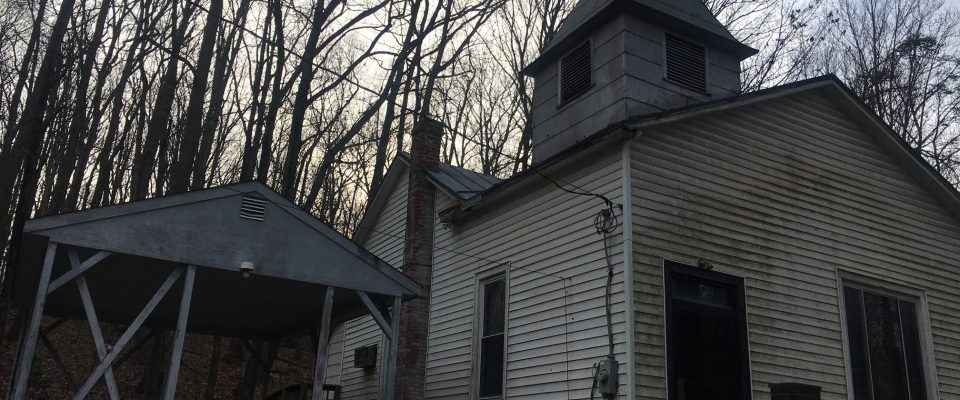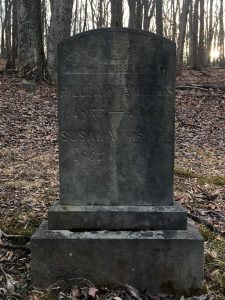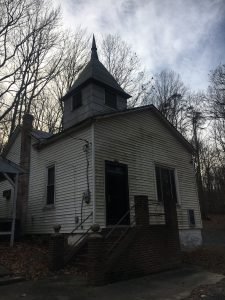By Lori Kimball
A physical testament to the strength and resilience of Loudoun’s African American community can be found in the Mount Pleasant Baptist Church and Cemetery, located at the base of the Catoctin Mountain on Bald Hill Road.
The small church and the adjacent social hall, which no longer stands, were once the spiritual and social heart of the community. A congregation no longer worships at Mount Pleasant, but the cemetery is still in use for burials of former members and their families.
An informal group was recently formed to determine if and how the church can be rehabilitated and to document the family histories of Mount Pleasant’s congregation and descendants. Calling themselves the “Friends of Mount Pleasant Baptist Church,” the group comprises representatives from the founding families andneighbors, the Black History Committee of the Friends of the Thomas Balch Library (http://balchfriends.org/), and the Lucketts Ruritan Club (https://luckettsruritan.org/).
The property’s earliest connection to the church site was in 1867 when Martha Ambers and Jacob Williams purchased an acre of land for $200 from Eliza and William Kitchen. They were recorded in the 1870 Federal Census as living with or on the property of Charles James, who owned land nearby. Martha was 38 years-old, and there was a young girl named Cecilia Ambers, age 7, with her. Cecilia is presumed to be Martha’s daughter. Jacob was age 45. Research to date has not indicated that Martha and/or Jacob were free before the Civil War, nor is it clear if they had been enslaved by Charles and were still living on his property after emancipation. Regardless, it was one of the earliest purchases of property in Loudoun by African Americans, only two years after the war’s end.
According to local historian and mapmaker Eugene Scheel, people worshiped at Liza Jenkins’ home on the mountain before the church was built. Reverend Charles Hadley was a traveling minister, who is documented as the first to lead the congregation at Mount Pleasant. Joyce Ambers, the great-granddaughter of Martha, said members held bake sales, fish fries, and lawn parties to raise funds to build a house of worship.
The first section of the church was dedicated in 1880. The foundation stone had been laid by Henry Mitchell, and Jewel Fry constructed the building. The date stone reads “M.P.B. Church October 24, 1880.” The original section of the church was one-story with a side gable.
Mount Pleasant was built during “the period of greatest growth for African-American communities in Loudoun County.” Approximately 30 churches were constructed between 1864 and 1900 to serve African-American congregations, and most consisted of one or two rooms. As with other small villages in the county, the church became the heart of the community.”
An exact date for the establishment of the cemetery is not known, but it likely could have been before the construction of the church. Many gravestones and markers still exist, and others have been lost to time. A layout of the cemetery has not been located to-date. This stone marks the graves of Hillary Ambers, son of Martha Ambers, and his wife Susan Virginia Bell.
The School
Another pillar of the community – a school – was built sometime after 1890 when School District No. 1 acquired an acre of land on the north side of Bald Hill Road. A one-room frame schoolhouse was built to educate African-American children who lived nearby. Instructors during the 20th-century were:
1923-1925 – Mrs. Annie B. Carroll
1925-1926 – Miss Anna A. Keys
1926-1927 – Mrs. Romaine G. Fletcher
1927-1929 – Mrs. Theodora A. Ross
1929-1932 – W.A. Walker – taught at Waterford for several years before Mount Pleasant
1932-1934 – Mrs. Effie Robertson Gray
1934-1935 and 1936-1937 – Blanche C. Beard Ambers – educated at Storer College
Mrs. Ambers was the second wife of Robert W. Ambers, who was the grandson of Martha Ambers. Education was important to the Ambers family. When conditions deteriorated in the schools for African-American children, Robert was actively involved with other parents advocating for improvements and for the construction of an accredited high school. In 1938, they formed the County-wide League to act as a unified voice. When the School Board resisted construction of a high school, parents raised funds and purchased eight acres of land on the then-outskirts of Leesburg. Robert Ambers was one of the League’s trustees, and his name is on the deed. Facing continued resistance, the group donated the land to the School Board, thus eliminating one of the Board’s excuses. Douglass High School, an accredited high school for African-American students, opened in 1941.
Growth of Mount Pleasant Church
In 1904, Jacob Williams sold his half interest in the Mount Pleasant parcel to Arthur C. and Catherine Williams. Two years later, the descendants of Martha Ambers conveyed the property to the Trustees of the Colored Baptist Church Mt. Pleasant. The heirs were Charles & Sarah Ambers, Hillery [sic] & Susan Ambers, Alice & Frank Jones, Ada & Samuel James, Arthur & Catherine Williams, John & Gertrude Williams, Maud & Robert Davis, Edward & Martha Thomas, Cora & Fillmore Newman, Lewis Wise, Arthur Wise, Joseph & Emily Williams (unmarried) all of Loudoun County; Maria & Arthur Craven, Joseph Ambers (unmarried) of NY; and Jacob & Bertha Williams of Maryland.
The congregation grew and in 1915, during the early years of Reverend R.L. Nickens’ pastorate, a front-gable addition was constructed at the front of the church. Both the original and newer sections feature open eaves and cornice returns. An enclosed belfry with square louvered vents was part of the early-20th-century addition and stands on the southeastern corner of the gabled roof.
At some point, an Odd Fellows Hall was built adjacent to the church. It was the home of the Grand United Order of Odd Fellows Mt. Pleasant Lodge No. 4217. Social and support organizations like the Odd Fellows were founded throughout the county by African Americans to aid one another during difficult times and to provide gathering places during segregation.
Life centered around the church, according to Joyce Ambers. There were several high days; July was Rally Day, and the first Sunday in August was Homecoming. Rally Day was a fundraiser, and Homecoming was a large event. Everyone brought food and ate in the Lodge Hall. In Eugene Scheel’s account of the community, he described outdoor brush arbor meetings in the summer and two-week revivals in late September and early October. “People would come out of the mountain, singing as they held their lanterns high.”
By the late 1990s or early 2000s, the pastor and some members of the congregation felt that the church needed updating and modernizing. It is believed that the two hand-carved wooden entrance doors from the original construction were removed and replaced with glass doors. Two windows in the front of the church were taken out and bronze-tinted windows inserted. The original layout featured solid walnut columns in the sanctuary, and they were also removed. A covered pavilion with a cement pad was built on the cemetery side of the building.
Additional renovations, such as handicap ramps and expansion of the choir loft, had taken place by the 123rd Church Anniversary celebration on October 19, 2003. It was also the 5th anniversary of Reverend Scott’s pastorate. His predecessors were honored in the program for Remembrance Day on Sunday, May 16, 2004.
Reverend Charles Hadley – 1880
Reverend R.L. Nickens – 1913-1961
Reverend John W. Thornton – 1961-1978
Reverend Louis V. Roberts – 1979-1991
Reverend Johnnie Shields – 1991-1997
Plans For Rehabilitating Mount Pleasant
Although the church has not been used for almost 10 years, former members of the congregation hope it can be rehabilitated and reused, even if it no longer functions as a place of worship. Descendants of Martha Ambers contacted several people and organizations seeking input and help, which led to the formation of the Friends of Mount Pleasant Baptist Church. The first step in determining the condition of the building and its potential for rehabilitation is conducting a structural analysis by an engineer with experience analyzing historic buildings.
To raise funds for this effort, the Lucketts Ruritan Club applied for and was awarded a grant from the Loudoun Preservation Society (www.PreserveLoudoun.org). The grant will cover half of the structural analysis. The other half must be raised by the Friends group. To donate to this worthy cause, click here and indicate your donation is to the MPBC project: https://luckettsruritan.org/donate-to-lucketts-ruritan
Future articles will cover genealogies and family stories of the congregation’s founding members, updates on the Friends’ progress to determine the feasibility and sustainability of rehabilitating the church, and their efforts to conduct oral histories of the congregation.



